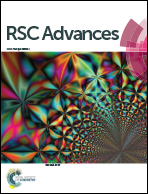Multi-modal MR imaging and magnetic hyperthermia study of Gd doped Fe3O4 nanoparticles for integrative cancer therapy†
Abstract
Among different kinds of cancer theranostic mediators, gadolinium (Gd) doped iron oxide nanoparticles are one of the most promising candidates in combining diagnostics (imaging) and therapeutics (molecular therapy) functions in a single, multimodal platform. Due to its larger size, the doping of Gd into the Fe3O4 is difficult. We have overcome this difficulty by modifying a polyol based reflux method that has been previously used for, for example, cobalt–zinc (Co–Zn) doping of ferrites but not for doping with Gd. This modified approach allowed a facile synthesis of Gd-doped superparamagnetic iron oxide (Fe3O4) nanoparticles (GdSPIONPs) with a lower Curie temperature (Tc) for hyperthermia superparamagnetism with low coercivity, both T1 and T2 based MRI contrast enhancements, low cytotoxicity and optimal hemocompatibility. Such a combination of theranostics properties in a single nanosystem is unprecedented and highly desirable for heat controlled magnetic hyperthermia in minimizing treatment resistance, and maximizing treatment efficacy.



 Please wait while we load your content...
Please wait while we load your content...